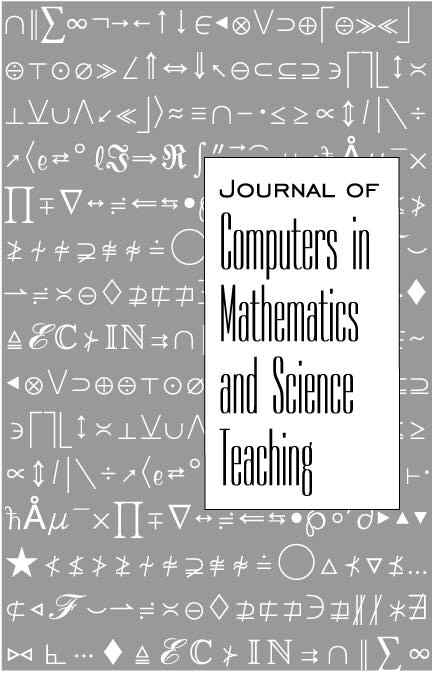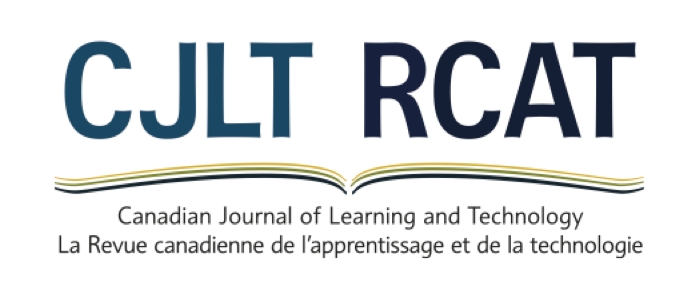Browsing by Subject: Classrooms
-

Learning about Surface Area through a Digital Fabrication-Augmented Unit
Kimberly Corum & Joe Garofalo, University of Virginia, United States
Journal of Computers in Mathematics and Science Teaching Vol. 35, No. 1 (January 2016) pp. 33–59
Surface area is consistently identified as a curriculum standard for K-12 students and it regularly appears on national and international assessments. Recently, many schools began acquiring digital... More
pp. 33-59
-

Teacher Self-Efficacy in 1:1 iPad Integration in Middle School Science and Math Classrooms
Lana Minshew & Janice Anderson, University of North Carolina at Chapel Hill, United States
Contemporary Issues in Technology and Teacher Education Vol. 15, No. 3 (September 2015) pp. 334–367
Many schools are beginning to adopt one-to-one computing with the goal of developing students’ 21st-century skills, which allow students not only to learn content but to acquire critical skills (e.... More
pp. 334-367
-

Pedagogically Effective Online Instructional Design Model
Li-Ling Chen, California State University at East Bay, United States
EdMedia + Innovate Learning 2015 (Jun 22, 2015) pp. 1551–1554
With the ever-increasing integration of online instruction or e-learning into university courses, there is a strong need for a pedagogically effective instructional design model for online... More
pp. 1551-1554
-

One-to-One iPad™ Usage and Applications in K-12 Classrooms
Julia Bennett, Beaver Area School District (Mathematics Educator), United States; Fan-Yu Lin, Department of Education, Robert Morris University, United States
EdMedia + Innovate Learning 2015 (Jun 22, 2015) pp. 1121–1126
Endorsing the concept of individualized instruction, mobile learning has improved student outcomes with innovative technology in the framework of 21st century learning and teaching. Out of a... More
pp. 1121-1126
-

Hands-on Learning in the Virtual Classroom: A Dilemma for Mathematics Teacher Educators
Linda Ann Arnold, Monmouth University, United States
EdMedia + Innovate Learning 2015 (Jun 22, 2015) pp. 1115–1120
The use of concrete manipulatives to help students learn mathematics has become accepted practice. Aspiring mathematics teachers at both the elementary and secondary levels take courses in which... More
pp. 1115-1120
-

Engaging College Students in Global Interaction via Digital Media: Setting the Stage for the International Writing Exchange (IWE) Project
Lyudmila Smirnova, Mount Saint Mary College, United States; Nellie Deutsch, University of Phoenix, Canada
EdMedia + Innovate Learning 2015 (Jun 22, 2015) pp. 802–805
Abstract Robust literature and experience with distant collaboration demonstrate the promise of globally connected classrooms. In the world of digital media and emerging technologies, it is easy to... More
pp. 802-805
-

Collect, Reflect, and Share Your Digital Badges – Micro-credentialing Student Achievements using Digital Badges
Enoch Park, Pfeiffer University, United States
EdMedia + Innovate Learning 2015 (Jun 22, 2015) pp. 738–739
As increasing number of students are engaged in learning opportunities and real-life experiences beyond the classrooms, it is important to adequately recognize their efforts and achievement. For... More
pp. 738-739
-

Adaptemy – Building the Next Generation Classroom
Ioana Ghergulescu, Conor Flynn & Conor O'Sullivan, Adaptemy, Ireland
EdMedia + Innovate Learning 2015 (Jun 22, 2015) pp. 86–95
This paper introduces Adaptemy, a smart, personalized and adaptive learning environment for classrooms. Adaptemy is constructed on existing research and aims to build the next generation classroom.... More
pp. 86-95
-

Redefining the Role of Online Facilitation in Digital Classrooms
Barbara Fedock, University of Phoenix, United States
EdMedia + Innovate Learning 2015 (Jun 22, 2015) pp. 22–24
With the inclusion of gaming and interactive simulations in digital classrooms, the role of online facilitation is constantly changing. Online instructors are no longer primarily virtual academic... More
pp. 22-24
-

Using Novel Video Indexing and Data Analytics Tool to Enhance Interactions in e-Learning
Shuangbao Wang, University of Maryland, United States; William Kelly, Metonymy Corporation, United States; Jie Zhang, Academy of Science, China
E-Learn: World Conference on E-Learning in Corporate, Government, Healthcare, and Higher Education 2015 (Oct 19, 2015) pp. 1919–1927
In this paper, we present a novel system - inVideo for video data analytics, and its use in learning analytics as the field strives towards new cultures of learning in the digital realm involving... More
pp. 1919-1927
-

The Era of BYOD: Augmented Reality Apps in Higher Education
Abrar Almoosa, University of Northern Colorado, United States
E-Learn: World Conference on E-Learning in Corporate, Government, Healthcare, and Higher Education 2015 (Oct 19, 2015) pp. 1684–1689
Students are showing up in the classroom with powerful computing devices. Given that, instructors are now able to integrate technology in their instruction. The main focus of this study is to... More
pp. 1684-1689
-

Game Me! What Pre-Service Teachers Should Know About Gaming and Gamification
Lorraine Beaudin, University of Lethbridge, Canada
E-Learn: World Conference on E-Learning in Corporate, Government, Healthcare, and Higher Education 2015 (Oct 19, 2015) pp. 1218–1221
In the last several years, educators have seen an increased awareness and interest in using gaming in the classroom. This paper provides a brief overview of some of the benefits of gaming and... More
pp. 1218-1221
-

Teachers’ Perception about their Competency in Integrating Technology in Elementary Classrooms using the Technological Pedagogical Content Knowledge Framework (TPACK)
Nadeyah Alqallaf & Mia Williams, University of Northern Colorado, United States
E-Learn: World Conference on E-Learning in Corporate, Government, Healthcare, and Higher Education 2015 (Oct 19, 2015) pp. 741–745
Teachers realize the importance of technology to promote enhancement in the transferring content knowledge. The problem exists around the effectiveness from integrating technology in educational... More
pp. 741-745
-

Simulating Future Scenarios: Translating In-Class Activities to Online Experiences
Leanna Archambault, Annie Warren & Robin Parmentier, Arizona State University, United States
E-Learn: World Conference on E-Learning in Corporate, Government, Healthcare, and Higher Education 2015 (Oct 19, 2015) pp. 263–266
The current study examines a popular in-class activity called “Renew-A-Bead,” which has been modified from a variety of online sources (see Powers, et al., 2013). It was adapted for a virtual... More
pp. 263-266
-

Engage Students with a Cloud-based Student Response System
Li Zhu, U.S. Naval Academy, United States
E-Learn: World Conference on E-Learning in Corporate, Government, Healthcare, and Higher Education 2015 (Oct 19, 2015) p. 51
Learning Catalytics is an advanced cloud-based student response system that can be used in lieu of clickers, such as TurningPoint and eInstruction clickers. Instructors push out questions to... More
p. 51
-
The Effect of the Integration of Corpora in Reading Comprehension Classrooms on English as a Foreign Language Learners' Vocabulary Development
Yahya Gordani
Computer Assisted Language Learning Vol. 26, No. 5 (2013) pp. 430–445
This study used a randomized pretest-posttest control group design to examine the effect of the integration of corpora in general English courses on the students' vocabulary development. To... More
pp. 430-445
-
When to Talk, When to Chat: Student Interactions in Live Virtual Classrooms
Phu Vu & Peter J. Fadde
Journal of Interactive Online Learning Vol. 12, No. 2 () pp. 41–52
This study explores students' choices of verbal and text interaction in a synchronous Live Virtual Classroom (LVC) environment that mixed onsite and online learners. Data were collected from... More
pp. 41-52
-
Leapfrogging Pedagogy: A Design Approach to Making Change in Challenging Contexts
Susan Crichton
Electronic Journal of e-Learning Vol. 12, No. 1 (2014) pp. 3–13
At a time of substantial change, globalization, and ubiquitous access to information, educators struggle to change even the most basic aspects of their classrooms. This is especially true for those... More
pp. 3-13
-
Research in Progress: Invited Colloquium--Foreign Languages in an Age of Globalization
Claire Kramsch
Language Teaching Vol. 46, No. 3 (July 2013) pp. 425–427
With the advent of globalization and the increasingly multilingual and multicultural nature of nations, institutions and classrooms, the fundamental nature of foreign language instruction is... More
pp. 425-427
-

Language Tasks Using Touch Screen and Mobile Technologies: Reconceptualizing Task-Based CALL for Young Language Learners
Martine Pellerin
Canadian Journal of Learning and Technology / La revue canadienne de l’apprentissage et de la technologie Vol. 40, No. 1 (May 09, 2014)
This article examines how the use of mobile technologies (iPods and tablets) in language classrooms contributes to redesigning task-based approaches for young language learners. The article is... More
